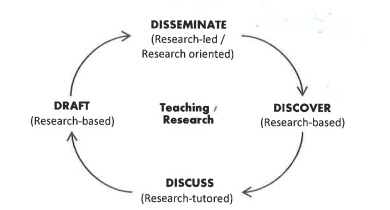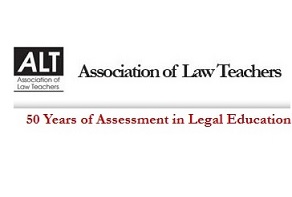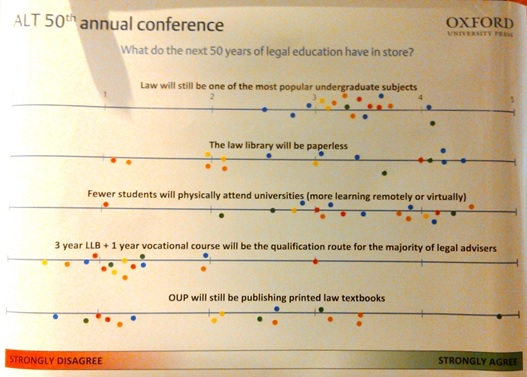This year, the Association of Law Teachers (ALT) had it 50th Annual Conference held at Cardiff. There were 2 keynotes, 6 parallel sessions comprising of 38 presentations and 2 discussions, and a Teaching Law with Technology Showcase. Participants are mostly law teachers and librarians from both higher and further education. This was my first ALT conference and I found it intriguing and a rewarding opportunity to hear about good practices and showcases from a range of Law schools. This blog post summarises the highlights of the conference:
Contents
Presentations
- Research-informed teaching: a clinical approach
by Alex Nicholson, Sheffield Hallam University
Amidst increasing competition within the higher education sector, many universities are committed to ensuring that their teaching is ‘research-informed’. However there is some disagreement amongst academics about what it is or how it should be delivered. The author draws upon the existing work of Griffiths (2004), Healey (2005) and others in an attempt to define “research-informed teaching” and then considers whether clinical or practical, client-based approaches to both teaching and research can offer more widely applicable strategies for effective integration of the two.
The author argued that research-informed teaching should be achieved in a way that is perceived to help employability, which is the primarily the objective of the majority of university applicants.

Figure: The clinical approach to research-informed teaching (Nicholson, 2015)
- The future of legal education: Can flipping the learning enhance the development of problem solving skills?
By Zoe Swan, University of Greenwich
This session shared the findings and experience of using flipped learning and a SCALE UP (Student-Centred Active Learning Environment Upside-down) style pedagogy for one term. The aim of the project was, to engage a group of 140 Law of Contract students, with an emphasis on developing problem-solving skills.
Voiced over PowerPoints were released weekly in advance of a teaching session, using Panopto. Panopto is a video platform used for sharing knowledge in various forms, including interactive screen capture. A variety of devices can be used to watch Panopto and the software is accompanied by statistics to track engagement. Problem-solving questions are then used as the mode of summative assessment. The evaluation suggests that the SCALE UP pedagogy improves a student’s conceptual understanding, ability to apply law to facts, improved achievement, improved attendance and higher levels of student satisfaction.
- From rote to realism: The role of clinical legal education in providing best practice in assessment and feedback
by Carol Boothby and Elaine Campbell, Northumbria University at Newcastle
Clinical legal education is the study of law and lawyering in context. Working with real clients with real problems allows law students to have hands-on legal experiences. Legal clinics are usually directed by clinical professors which typically do pro bono work in a particular area, providing free legal services to clients.
One of the most significant changes in legal education during the last 50 years has been the increase in experiential learning and, in particular, clinic as a vehicle for educating lawyers. Many of these clinical programs are assessed. Given that assessment and feedback have been scoring low in the National Student Survey, clinical teaching provides the perfect environment for institutions to embed good practice for assessment and feedback, as well as providing opportunities for students’ personal development and reflection.
- How to assess?
- Clinical work is an integration of competences. Assessment is a ‘whole task’ approach
- Inclusive/general approach requires adaptive description in feedback. This is to ensure that flexible and all-rounded approaches are built in to reflect the holistic approach of the assessment.
- Types of feedback provided
- Various styles of feedback are provided on letters to clients
- Mid-year appraisal
- Actualised clinical experience (ACE).
- Challenges
- Assessors need to be well-trained
- Portfolio work is split between paperwork and email
- Some clients find confidentiality an issue with the use of VLE and other software.
- ‘That’s entertainment folks!’ Legal education for the masses
by Hugo de Rijke, Plymouth University
This session presented the potential for embedding popular culture within legal education. Law Literature and Film uses popular culture as an invaluable pedagogical tool.Society’s perception of law and its representation, the impact of popular culture upon law and vice versa is considered in this module. Furthermore, when dealing with increased student numbers and widening participation, it is argued that entertainment provides an excellent opportunity to hold the attention of larger groups. Finally, and perhaps more controversially, students are more ‘satisfied’ for NSS purposes if they are entertained in the right ways.
- Delivery: The module ‘Law, Literature and Film’ is delivered to final year LLB students as an elective module. This includes:
- 2 hours workshops include lectures, Q&A, group discussion and exercises
- 1 film screening/watching at home
- 4 readings on novels or plays
- Formative assessment includes ideas, plans and drafting, and summative consists of 2 essays.
- Student Perspective
- Students learn more about law through popular culture
- Students can focus on disciplines/topics which they are interested in
- Students expect to be entertained, are paying for this privilege, and are ultimately more ‘satisfied’ for NSS purposes.
Teaching Law with Technology Showcase
OpenLawMap
by Michael Doherty, University of Central Lancashire
In 2014, law mapping and blogging was introduced to the law Year 1 undergraduate students through the creation of a Preston Law Trail. This identified four sites, all within a short walking distance of the Law School at University of Central Lancashire, which have legal significance. For each site, a short description and a series of quiz questions were provided. Students were put into groups and tasked with locating the site, taking and uploading group photos in front of the site, and using their smartphones to answer the quiz questions. In classes, students were put into small groups and allocated one of three topics based on these sites. Each group then produced a short blog entry, with the winning entries in each category winning a prize and having their entry posted on the Open law map: http://openlawmap.co.uk/
What do the next 50 years of legal education have in store? (A technology-free poll)
My first experience of ALT Annual Conference was stimulating. The conference provided some interesting and thought-provoking ideas and related challenges in law teaching, especially around clinical legal education and student engagement.
References
- Healey, M. (2005). Linking research and teaching: exploring disciplinary spaces and the role of inquiry-based learning. In: Barnett (ed). Reshaping the University: New Relationships Between Research, Scholarship and Teaching. Maidenhead: McGraw-Hill / Open University Press, pp. 67-78.


